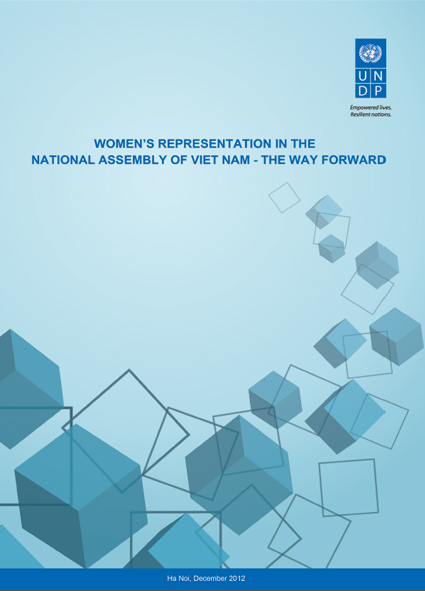Women’s Representation in the National Assembly of Viet Nam - the way forward
Viet Nam has always placed a strong emphasis on gender equality. This has resulted in important achievements such as low maternal mortality and high access to education. Indeed, Vietnamese women have one of the highest labour force participation rates in the world. On most gender indicators Viet Nam compares positively in international rankings, especially compared to other countries in the Asia-Pacific region.
Despite strong legal and policy guidelines, Viet Nam has not reached its own targets on the number of women elected. This study, based largely on interviews with current and former female Members of Parliament and representatives of the Viet Nam Women’s Union, the Fatherland Front, government officials and social organizations, indicates that there are a number of ways that the process could be improved to increase the number of women who are successful in elections. According to Viet Nam’s political system, there is a strong reliance on “structure” (cơ cấu) in the electoral process. Decisions are made at the highest levels regarding which societal groups need to be represented in the National Assembly, and this “structure” is sent to provincial authorities, who strive to find electoral candidates who can best represent these important social sectors.
The recommendations include areas where there are already fewer women, such as senior officials from the local government, state enterprises, trade unions, the police and military and other social sectors. Therefore, even though there is a target of 30-35% women, most local authorities have difficulty finding enough women who match the criteria. As a result, the few “open” spots are filled with individuals who fall into several “quota” groups at the same time – for instance a young, female ethnic minority.
At the beginning of the process, the Viet Nam Women’s Union proposes between 45-50% women as candidates. However in 2011, once all interests and “structure” was applied, the number of female candidates was only 37%. This is partly because over one third of the electoral candidates are nominated by the central level, and consist of incumbent MPs and senior officials, where women are significantly under-represented. There are also very few self-nominated candidates who are successful in elections. In this environment, the relative placement of women on the ballot is extremely important. If women are positioned alongside men who are equally or more qualified, usually the man will be elected. This is also a result of patriarchal attitudes in society and within families. As a result, only 24.4% of the successful candidates in the last election were women.
The main recommendations in the report include: increasing awareness of the benefits of electing women; enhancing accountability and oversight mechanisms to ensure implementation of the national gender policies; promoting more women to senior positions, from which electoral candidates are drawn and ending official age discrimination for women. There is also a list of suggestions drawn from the interviews and listed thematically that can be easily implemented. These include ways to improve the pool of qualified candidates by reducing societal stereotypes, promoting more women to senior positions and eliminating barriers to women’s advancement. In addition, there are suggestions about how to enhance women’s capacity to run effective election campaigns and to position women more strategically on the ballot. The annex includes specific suggestions for the various organizations involved in the electoral process, including the Communist Party, the Viet Nam Women’s Union, the Fatherland Front, Government Ministries and other actors. Together, implementation of the recommendations and suggestions would have an immediate effect of reversing the current downward trend and ensuring that Viet Nam emerges once again as a global leader on women’s leadership and representation.
Full text of Women’s Representation in the National Assembly of Viet Nam - the way forward: anitareportfinalen.pdf
 |
- Hôm nay 479
- Tổng lượt truy cập 6,864,659


Bình luận từ Facebook
Phản hồi